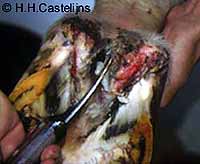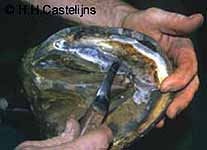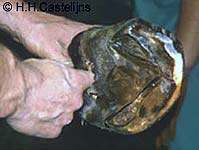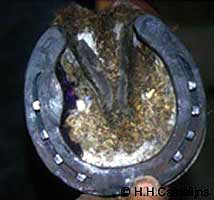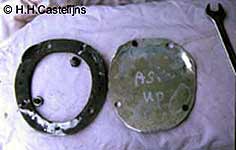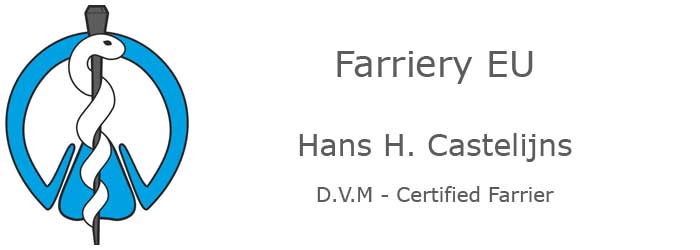 |
Hospital plates: bruises, abscesses and cankerDisorders of the sole, frog and white line, such as bruises and abscesses, are causes of lameness in horses that farriers and equine veterinarians frequently encounter in the course of their work. Canker (chronic hypertrophic pododermatitis), which is usually associated with poor hygiene, is possibly less common nowadays, but unfortunately this relatively dramatic-looking disorder is still seen far too frequently. |
||||
|
||||
A common feature of all these disorders of the sole is that their treatment requires the farrier to fit some form of protection, normally detachable, in addition to the usual horseshoe. Bruises differ from abscesses in that bruises are aseptic whereas abscesses are infected by microbes. They are diagnosed by studying the patient's history (anamnesis), probing the foot, and judicious use of a hoof knife. Abscesses affect the dermis of the hoof and, if untreated, break out at specific places in relation to the affected dermis (corium), because the infection cannot find a way out through the keratinised parts of the hoof capsule. Infections of the solar corium, even those originating in the toe, undermine the sole and break out at the hoof bulbs, in the same way as infections of the corium of the frog. |
||||
|
||||
Where it is not possible to carry out drainage through the keratinised parts under which the infection is located, abscesses of the laminar corium or of the white line always migrate upwards parallel to the hooftubules of the hoofcapsule and break out at the coronet. Draining, carried out with the aid of a hoof knife, provides an opening to the infected part, permitting treatment, but also inevitably exposes raw tissue by removing the horny protection. After draining, the infection can be treated with dressings (Betadine, Sugardine, Animal Lintex, etc.) but reinfection of the exposed tissue must be avoided, as must direct trauma. In the case of small abscesses or bruises, for example those that are frequently found at the seat of corn (which seem to act as a natural trap for microbes), a little creativity with a slightly modified shoe can cover the area in question to permit local medication and protect the exposed corium from trauma. |
||||
|
||||
More effective protection can be achieved by applying a rigid plate, which must be detachable to permit the administration of medical treatment at regular intervals. In the case of canker, which calls for frequent treatment (50/50 picric acid and salicylic acid in powder form every three days), after radical surgical removal of the diseased tissue the use of such a detachable plate is almost always necessary. Literature on farriery, as well as many schools, provide numerous different examples of this type of shoe with detachable plates, which are often time-consuming and/or difficult to make on the spot. One model that is easy to make, and very versatile due to the ease with which it can be manipulated by the person responsible for the patient's care, consists of a rigid plate (of aluminium, plastic or metal) cut to the external dimensions of the shoe, in which four threaded holes are bored and to which the plate can be fixed with four hexagon head screws. On completion of the treatment, the plate is removed permanently and the horse is shod "normally". |
||||
|
||||
A more limited, but valid, solution for less serious cases is provided by a commercial product that has come onto the market recently under the name Easy pad © *. This consists of a semi-rigid plastic plate that is cut to the exact dimensions of the inner lip of the shoe. This is held in place with the aid of two thin steel strips (fixed to the plate by small copper rivets) that are slipped under the upper surface of the shoe. The Easy pad can be fitted and removed easily due to the fact that it is semi-rigid and can be folded lengthwise to enable the side strips to be slipped in under the upper surface of the shoe. Another "ready made" solution is the Open Up© hospital pad produced by Mustad Hoofcare. |
||||
|
||||
When there is a need to cover the exposed parts of the wall or to hold dressings in place as far up as the bulbs, as in the case of some cankers that have been operated on, the best solution is still the aluminium plate, since this material is light, strong and can be shaped on the anvil. |
||||
|
||||
Although making shoes with detachable plates is a rather technical operation, such shoes are an essential part of the treatment of many bruises, abscesses and cankers, because they are stronger and their application less laborious than frequent, single-use dressings. Furthermore, they are much less risky than applying a fixed plate which, in the case of complications or a relapse of the condition, means removing the shoes completely (from what are often painful feet). The detachable plate can be removed permanently once the damaged area has regrown a new layer of horny tissue. |
||||
Hans Castelijns
D.V.M - Certified Farrier
